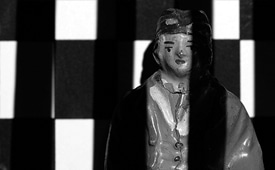
CHSOS just added 3D scanning by Structured Light using a mini (pico) projector coupled with the “3D scanning software” developed by Daniel Moreno and Gabriel Taubin. The free software can be downloaded from Brown University School of Engineering. I need to thank Daniel for his support with the software. Pico projectors are extremely small: a fraction of the size and weight of traditional projectors. They use LEDs technology instead of lamps. They were developed for traveling professionals needing a projector that could fit into their suitcases and help them deliver presentations while traveling for meetings. The small size of these pico projectors make them suitable also for very detailed structured light 3D reconstruction. Indeed, since they are so small they can get very close to the object to be scanned and so the structured light pattern can be projected only on a small area, acquiring consequently a relatively high resolution 3D scanning.
 We do run a lot of initiatives, Stay on top of things!
We do run a lot of initiatives, Stay on top of things!

CHSOS chose a new AAXA P300. This has the currently higher native resolution, 1280×800 pixels. Brightness is relatively low (300 lumens), but this doesn’t affect the quality of the scanning since the projector is very close to the subject (few tens of centimeters) and the lighting is, therefore, sufficient. Indeed, we want to use structured light for very detailed scanning of small details. Amazing structured light 3D scanning can be realized with these projectors, such as the work done by Tim Zaman. Here is the calibration panel I made for scanning with “3D scanning software” by Daniel and Gabriel. Download check board (3035 downloads )









Hi Antonino, first of all I would like to thank you for sharing your experience.
Since I’m quite new to the use of structured light in 3D scanning, I would like to ask you how does it compare to plain photogrammetry? What are the pros and cons of the two techniques? Is there a difference in the level of detail that can be captured?
Thanks
Michele
Hi Michele,
structured light is to be preferred if you need to scan very flat surfaces, such as paintings, which is what I plan to use it. For scanning of 3D objects photogrammetry (software such as Agisoft) are better.
I would love to see the results of this and other examples. Specifically, of painting, as you mention above.
yes, I hope to have them soon. Right now I’m collaborating with Daniel at Brown University who is kindly working on the software to enhance the detail and resolution that can be achieved. This will take some time, it seems they are pretty busy at Brown University, I guess 🙂
Hi Antonio, great to see you jumping on the 3D boat. How’s things in Sicily? I suggest in the next iteration moving from binary structured light to fringe projection, as it moves the resolution constraint from the projector to that of the camera, which has 40 times as many pixels. I have some info written up here: http://www.biomedcentral.com/content/pdf/s40494-014-0023-0.pdf .
Hi Tim! thanks for the info!
yes, I was planning to do some structured light for my work on paintings documentation and stumbled upon the Brown’s group software and have been experimenting a little bit. I wish I could achieve something like your amazing work 🙂 Not that much but at least good enough to document features such as brushworks, incisions, retouchings
You can try Russian3DScanner, but this software work only with Canon DSLR.
http://www.russian3dscanner.com/scanner-download
hi, thanks so much for the info! can wait to try them. are you using this software for art documentation? for our applications we need the highest detail possible. have you experience with this kind of tasks? like the surface of a painting?
You can try for 3DScanning – Russian3DScanner, but this software work only with Canon DSLR.
http://www.russian3dscanner.com/scanner-download
or this sftware: http://www.3dunderworld.org/software/
Hi Antonino,
Thank you for sharing your work. I an pretty new to 2D scanning
As far as I can see, the scanning software by Daniel Moreno and Gabriel Taubin only captures pictures from a webcam.
How did you manage to trigger the shutter of your DSLR camera?
Hi Jueng,
I just did shutter manually. You can delay the sequence so you have time to manually trigger your camera.
cheers
A